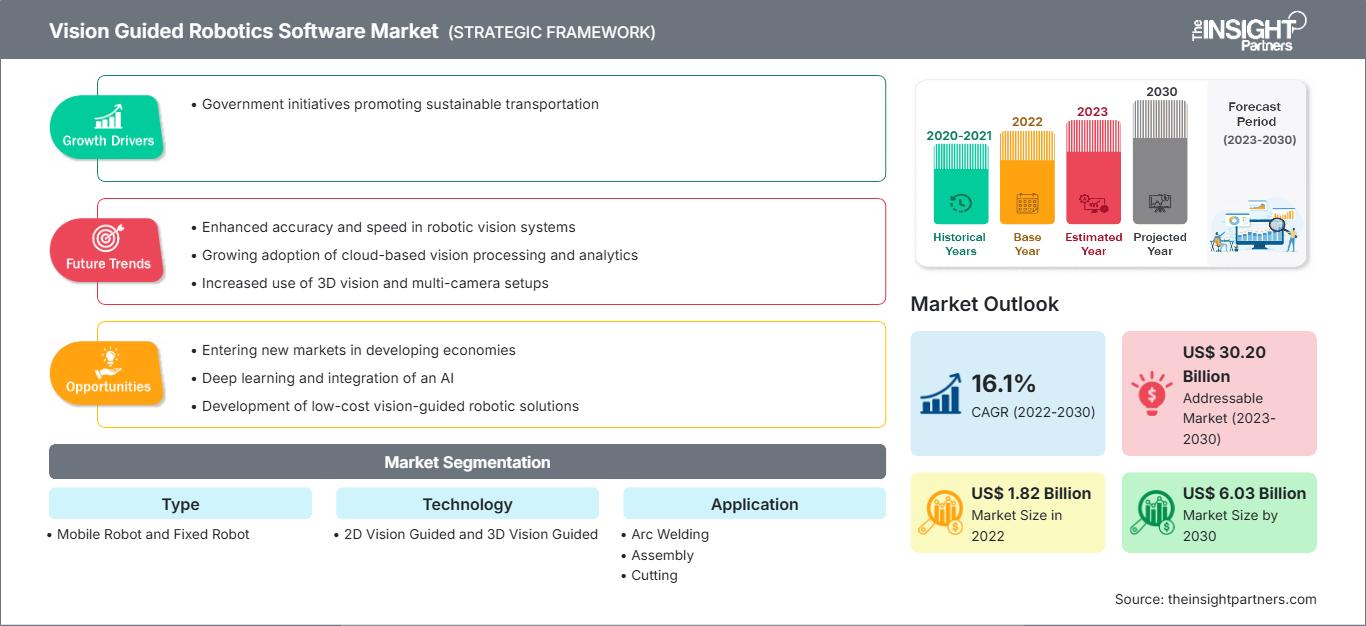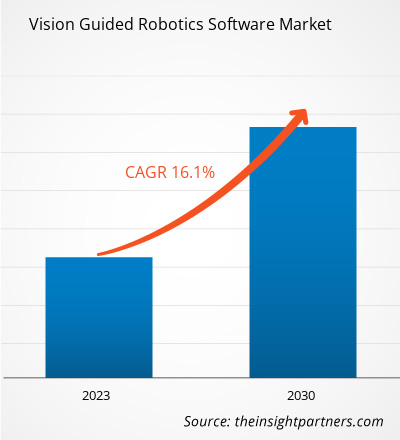[研究报告] 2022 年,视觉引导机器人软件市场价值为 18.2 亿美元,预计到 2030 年将达到 60.3 亿美元;预计 2022 年至 2030 年的复合年增长率为 16.1%。
分析师观点:
视觉引导机器人软件市场高度分散,参与者众多。为了在行业中保持领先地位并与同行竞争,各公司采取了多种策略,包括具有竞争力的价格、微型技术、基于云的技术、并购以及额外的售后服务。这些策略为公司提供了显著的竞争优势。考虑到各发展中国家的政府都允许外国直接投资 (FDI) 以精确、轻松地优化各行业单调而繁忙的操作,视觉引导机器人软件市场有望在未来几年蓬勃发展。此外,终端用户对 3D 视觉技术的需求正在快速增长,这促使制造商不断创新,开发用于机器人系统的强大软件。3D 视觉系统与 RoboRealm 和 Visionscape 等机器视觉软件相结合,能够提升视觉引导机器人执行各种任务的性能,从而推动视觉引导机器人软件市场份额的增长。集成机器视觉软件的视觉引导机器人适用于拾取和放置、箱体拾取、焊接、装配、上架、分配和产品分拣等应用。由于 3D 视觉技术与机器视觉软件相结合的优势,终端用户越来越多地采用最新技术,从而推动了全球视觉引导机器人软件市场的增长。
市场概览:
视觉引导机器人软件应用于各个垂直领域,用于提取、表征和解读特定产品的信息,并执行所需的自主任务(无论是机械还是电气任务)。视觉引导机器人市场的公司始终致力于开发先进技术,以进一步提升自动化水平,并帮助制造业强化其流程。传感器技术和处理能力的进步使机器人能够承担更多任务,例如飞行、驾驶和移动活动,这些任务都需要通过视觉系统实现避障和识别能力。对于机器人制造商而言,开发强大的视觉引导机器人的首要领域包括成像硬件的进步、计算能力的快速提升、高级软件库的改进以及计算机内存成本的降低。此外,机器视觉的发展也将推动工业领域自动化技术的发展。
自定义此报告以满足您的要求
您将免费获得任何报告的定制,包括本报告的部分内容,或国家级分析、Excel 数据包,以及为初创企业和大学提供超值优惠和折扣
视觉引导机器人软件市场: 战略洞察

-
获取本报告的主要市场趋势。这个免费样本将包括数据分析,从市场趋势到估计和预测。
市场驱动因素:
大规模定制的巨大潜力推动视觉引导机器人软件市场增长
全球主要制造公司正在采用智能技术,旨在减少日常挑战。消费者对定制机器人的需求日益增长,以满足组织内各种单调的工作,并且这些机器人可以随着时间和需求的变化而轻松升级。产品的不断改进使成千上万的公司能够以比传统大规模生产商更低的成本进行投资,这推动了视觉引导机器人软件市场的发展。视觉引导机器人软件可以根据消费者的需求随时更新。与行业中的系统安装或更换新系统相比,这种软件更新为用户带来的成本更低。
汽车、航空航天、医疗保健、物流、运输和制造等行业将其工作站与机器人技术高度集成。近年来,各机器人公司纷纷开发视觉引导机器人,改变了全球自动化格局,因为这些机器人比传统机器人具有多种优势。这些机器人能够执行多任务并携带摄像头,从而减少传感器技术的集成。这些机器人高度精确且高效。因此,大规模定制的巨大潜力正在推动视觉引导机器人软件市场份额的增长。
报告细分和范围:
视觉引导机器人软件市场根据类型、技术、应用和垂直领域进行细分。根据类型,视觉引导机器人软件市场细分为移动机器人和固定机器人。在技术方面,视觉引导机器人软件市场分为 2D 视觉引导和 3D 视觉引导。根据应用,视觉引导机器人软件市场分为电弧焊、装配、切割、码垛和机器看管、导航、随机拾取、协作机器人等。在垂直领域,市场细分为汽车、电气和电子、航空航天、医疗保健、运输和物流、食品和饮料等。按地区划分,视觉引导机器人软件市场分为北美、欧洲、亚太地区 (APAC)、中东和非洲 (MEA) 以及南美 (SAM)。
分段分析:
按类型划分,视觉引导机器人软件市场分为移动机器人和固定机器人。固定机器人细分市场在 2022 年占据了较大的视觉引导机器人软件市场份额,预计在预测期内将会增长。固定机器人因其具有各种可互换工具的优势,广泛应用于多个行业。这些机器人需要足够的编程才能执行任务,目前,不同的软件、摄像头和传感器被安装到这些自主系统中以增强其能力,从而增加了细分市场的份额并推动了视觉引导机器人软件市场的发展。通常,固定机器人安装在工业中用于焊接、放置、固定和成型等。借助先进的成像系统、传感器和软件,固定机器人的运行效率得到提高,使这些系统能够自行理解任务,从而扩大了视觉引导机器人软件市场规模。
区域分析:
2022 年,亚太地区占据了最大的视觉引导机器人软件市场份额。大型汽车、半导体和电子制造业的兴起促使人们采用自动化机器人来提高操作精度,从而扩大了视觉引导机器人软件市场规模。中国和日本拥有强大的电子工业,这些工业使用视觉引导机器人进行零部件制造、零件拾放、在 PCB 上组装微型零部件、涂抹粘合剂、检查、测试和包装。亚太地区正在大力推动视觉引导机器人软件市场的发展和创新。该地区包括中国、印度和东南亚等多个发展中经济体。亚太地区在视觉引导机器人软件领域提供了巨大的机遇,可以实现工作自动化,从而推动视觉引导机器人软件市场的发展。一些公司已经制定了未来几年在机器人中实施该软件的愿景和战略。相比之下,许多企业仍在计划采用全自动化操作,预计这将推动视觉引导机器人软件市场的发展。此外,中国视觉引导机器人软件市场正在增长。中国是机器人密度最大的国家之一。中国汽车行业的机器人采用率显著上升,已超过美国和德国。例如,根据国际机器人联合会的数据,2021年中国制造业的运营机器人数量达到每10,000名员工322台,首次超过美国的机器人密度(每10,000名员工274台)。此外,该地区许多国家都是制造业中心,这增加了向该地区扩张的公司数量。这导致了新的制造工厂和工厂的出现,创造了对自动化的需求,而机器人的大量安装,正在推动视觉引导机器人软件市场的发展。此外,电子设备制造领域对自动化日益增长的需求预计将推动机器人的安装。这将推动视觉引导机器人软件市场的发展。
主要参与者分析:
本报告介绍了视觉引导机器人软件市场的主要参与者,包括ABB有限公司、发那科公司、康耐视公司、欧姆龙公司、MVTec Software GmbH、Pick-it NV、Ready Robotics Corporation、西门子股份公司、泰瑞达公司和Robotic Vision Technologies (RVT), LLC。
视觉引导机器人软件市场区域洞察
The Insight Partners 的分析师已详尽阐述了预测期内影响视觉引导机器人软件市场的区域趋势和因素。本节还讨论了北美、欧洲、亚太地区、中东和非洲以及南美和中美洲的视觉引导机器人软件市场细分和地域分布。
视觉引导机器人软件市场报告范围
| 报告属性 | 细节 |
|---|---|
| 市场规模 2022 | US$ 1.82 Billion |
| 市场规模 2030 | US$ 6.03 Billion |
| 全球复合年增长率 (2022 - 2030) | 16.1% |
| 历史数据 | 2020-2021 |
| 预测期 | 2023-2030 |
| 涵盖的领域 |
By 类型
|
| 覆盖地区和国家 |
北美
|
| 市场领导者和主要公司简介 |
|
视觉引导机器人软件市场参与者密度:了解其对业务动态的影响
视觉引导机器人软件市场正在快速增长,这得益于终端用户需求的不断增长,而这些需求的驱动因素包括消费者偏好的不断变化、技术进步以及对产品优势的认知度不断提高。随着需求的增长,企业正在扩展其产品线,不断创新以满足消费者需求,并抓住新兴趋势,从而进一步推动市场增长。

- 获取 视觉引导机器人软件市场 主要参与者概述
最新动态:
视觉引导机器人软件市场参与者高度采用无机和有机策略。以下列出了一些近期的关键市场动态:
- 2023年12月,Mecalux(一家全球领先的自动化仓库解决方案、仓库管理系统和堆垛机供应商)与西门子整合了各自在工业自动化技术领域的专业知识和经验。此次合作将利用全新的人工智能解决方案优化仓库和物流中心的拣选任务。该解决方案基于西门子Xcelerator,这是一个开放式数字业务平台,拥有软件和支持物联网的硬件产品组合、合作伙伴生态系统以及市场。
- 2023年11月,ABB机器人公司扩展了其免费Wizard Easy Programming软件的适用范围,将搭载OmniCore控制器的六轴工业机器人及其协作机器人纳入其中。这使得 ABB 成为第一家为协作机器人和六轴工业机器人提供易于使用、无代码编程工具的机器人制造商,从而降低了新用户实现自动化的门槛,并为生态系统合作伙伴和集成商提供了高效的工具来支持他们的客户。
- 2023 年 8 月,OSARO(电子商务机器学习机器人领域的全球领导者)欢迎康耐视公司(工业机器视觉领域的领导者)加入 OSARO 合作伙伴联盟——一个为客户提供最佳自动化解决方案的专业生态系统。通过将康耐视 DataMan 固定式基于图像的条码读取器集成到 OSARO 机器人装袋系统中,OSARO 解决了 Zenni Optical 面临的一项艰巨的技术挑战。
- 2023 年 2 月,ABB 发布了其 SWIFTI CRB 1300 工业协作机器人,其负载处理能力扩展至高达 11 公斤,并在解决方案中具备码垛和取放等功能。该产品有望弥合工业机器人和协作机器人之间的差距。
- 历史分析(2 年)、基准年、预测(7 年)及复合年增长率
- PEST和SWOT分析
- 市场规模、价值/数量 - 全球、区域、国家
- 行业和竞争格局
- Excel 数据集
近期报告
相关报告
客户评价
购买理由
- 明智的决策
- 了解市场动态
- 竞争分析
- 客户洞察
- 市场预测
- 风险规避
- 战略规划
- 投资论证
- 识别新兴市场
- 优化营销策略
- 提升运营效率
- 顺应监管趋势






















 获取免费样品 - 视觉引导机器人软件市场
获取免费样品 - 视觉引导机器人软件市场